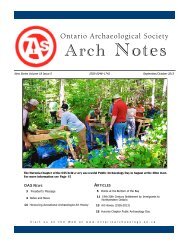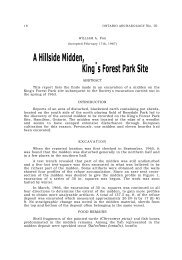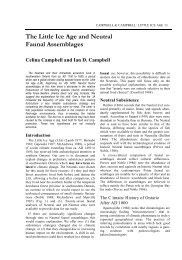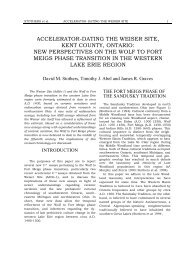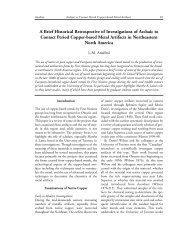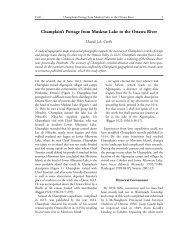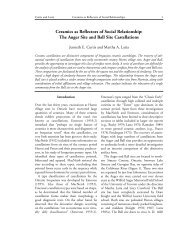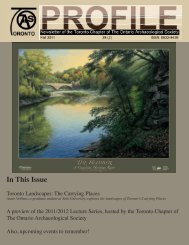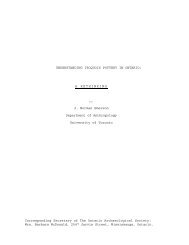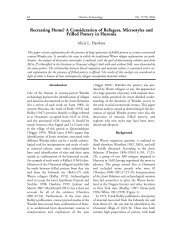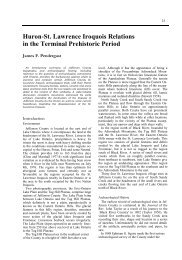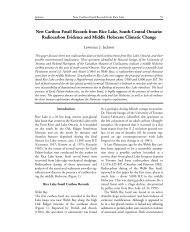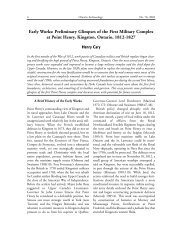The Norton Site - Ontario Archaeological Society
The Norton Site - Ontario Archaeological Society
The Norton Site - Ontario Archaeological Society
Create successful ePaper yourself
Turn your PDF publications into a flip-book with our unique Google optimized e-Paper software.
COOPER AND ROBERTSON: THE NORTON SITE... 53<br />
Table 9. <strong>Norton</strong> site (AfHh-86) plant remains: absolute numbers of seeds<br />
PLANT REMAINS PROVENANCE TYPE SPECIES CONTRIBUTIONS<br />
ABSOLUTE # SEEDS HOUSEMIDDEN A F119 SUMS% FEATURES<br />
Maize 13 2 1 16 4.42<br />
Sunflower 4 4 1.10<br />
Tobacco 17 9 26 7.18<br />
Black Nightshade 3 6 1.66<br />
Elderberry 2 3 3 5 1.38<br />
Strawberry 4 4 1.10<br />
Bramble 13 2 15 4.14<br />
Chenopod 1 2 7 10 2.76<br />
Knotweed 1 10 11 3.04<br />
Cattail 119 1 120 33.15<br />
Aralia 1 1 0.28<br />
Cleaver 1 1 0.28<br />
Sumac 4 1 1 6 1.66<br />
Ironwood 1 1 0.28<br />
Purslane 2 4 2 8 2.21<br />
Unknown 4 3 1 8 2.21<br />
Unidentifiable 43 74 3 120 33.15<br />
Total 232 102 28 362 100.0<br />
to examine the implications of each species.<br />
Gathered faunal resources may be procured by<br />
hand by elderly people or children and the material<br />
technology required is generally simple. Six<br />
specimens representing as many species fall into this<br />
category. Five freshwater mussel species and one<br />
turtle species were identified, accounting for<br />
approximately 3% of the sample. None of the<br />
gathered species, nor even all mussel species<br />
combined, were present in quantities sufficiently large<br />
to indicate a harvest level of exploitation. Small game<br />
may be hunted with projectile weapons but may also<br />
be taken with deadfall traps, snares, etc. <strong>The</strong>refore<br />
small game may have been taken by men and<br />
women, young and old alike, and was most probably<br />
pursued locally (Steward 1968: 326). Eight<br />
specimens representing five species (wild turkey,<br />
woodchuck, muskrat and grey and red squirrel) fall<br />
into this category accounting for approximately 8% of<br />
the sample. <strong>The</strong> data in the analyzed sample indicate<br />
that none of the small game resource<br />
species was exploited at harvest levels. One<br />
specimen was tentatively identified as the right ulna of<br />
a hairy woodpecker (Picoides villosus). Given that the<br />
behaviour of this species does not make it particularly<br />
vulnerable to human exploitation its meagre nutritive<br />
value would scarcely justify pursuit. It may therefore<br />
have been taken for its attractive black and white<br />
plumage.<br />
Fishing as a subsistence activity can probably be<br />
equated with small game hunting. Six fish specimens<br />
were identified or nearly 3% of the total sample. None<br />
of the five species represented are present in<br />
quantities suggesting harvesting nor are these<br />
species closely associated with spawning run<br />
exploitation. Aquatic resources including fish, mussel,<br />
turtle and muskrat contributed fourteen specimens,<br />
approximately 6% of the total. All could have been<br />
procured locally. Given the site's proximity to the<br />
Thames River, such resources appear to be grossly<br />
under-represented. <strong>The</strong> heavy flotation fraction<br />
however has yet to be fully



